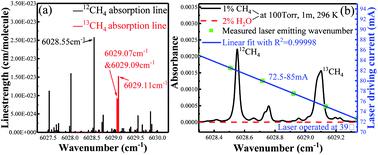Our official English website, www.x-mol.net, welcomes your
feedback! (Note: you will need to create a separate account there.)
High-precision methane isotopic abundance analysis using near-infrared absorption spectroscopy at 100 Torr
Analyst ( IF 3.6 ) Pub Date : 2020-11-09 , DOI: 10.1039/d0an01588a Zhiwei Liu 1, 2, 3, 4, 5 , Chuantao Zheng 1, 2, 3, 4, 5 , Tianyu Zhang 1, 2, 3, 4, 5 , Yu Zhang 1, 2, 3, 4, 5 , Yiding Wang 1, 2, 3, 4, 5 , Frank K. Tittel 6, 7, 8, 9
Analyst ( IF 3.6 ) Pub Date : 2020-11-09 , DOI: 10.1039/d0an01588a Zhiwei Liu 1, 2, 3, 4, 5 , Chuantao Zheng 1, 2, 3, 4, 5 , Tianyu Zhang 1, 2, 3, 4, 5 , Yu Zhang 1, 2, 3, 4, 5 , Yiding Wang 1, 2, 3, 4, 5 , Frank K. Tittel 6, 7, 8, 9
Affiliation

|
A near-infrared methane (CH4) sensor system for carbon isotopic abundance analysis was developed based on laser absorption spectroscopy (LAS). For good thermal stability, two CH4 absorption lines with a similar low-state energy level were selected to realize relative weak temperature dependence. Wavelet denoising (WD) was employed for a pre-treatment of the direct absorption spectral (DAS) signal to perform a preliminary suppression of high-frequency noise. Due to the abnormal 13CH4 profile caused by superimposition of multiple lines, two statistical analysis algorithms including linear regression and neural network prediction were respectively employed on the retrieval of molecule fractions instead of the traditionally used standard absorption line fitting method. Performance assessment and a comparison between the two methods were carried out. Compared with the concentration deducing method based on the maximum absorbance in rough data, the linear regression and the neural network prediction obtained a sensitivity enhancement by ∼2 times and ∼10 times, respectively. A simultaneous measurement of pressure and concentration was performed using the neural network, which indicated a good potential of the technique for multi-parameter analysis using a single LAS-based sensor system.
中文翻译:

使用100 Torr的近红外吸收光谱法进行高精度甲烷同位素丰度分析
基于激光吸收光谱(LAS),开发了一种用于碳同位素丰度分析的近红外甲烷(CH 4)传感器系统。为了获得良好的热稳定性,选择了两个具有相似低能级的CH 4吸收线以实现相对较弱的温度依赖性。小波降噪(WD)用于直接吸收光谱(DAS)信号的预处理,以执行高频噪声的初步抑制。由于13 CH 4异常由多条线的叠加引起的剖面图,分别采用线性回归和神经网络预测这两种统计分析算法来代替分子分数,代替了传统的标准吸收线拟合方法。进行了性能评估并比较了这两种方法。与基于粗数据中最大吸光度的浓度推导方法相比,线性回归和神经网络预测分别将灵敏度提高了约2倍和10倍。使用神经网络同时测量压力和浓度,这表明使用基于LAS的单个传感器系统进行多参数分析的技术潜力很大。
更新日期:2020-11-19
中文翻译:

使用100 Torr的近红外吸收光谱法进行高精度甲烷同位素丰度分析
基于激光吸收光谱(LAS),开发了一种用于碳同位素丰度分析的近红外甲烷(CH 4)传感器系统。为了获得良好的热稳定性,选择了两个具有相似低能级的CH 4吸收线以实现相对较弱的温度依赖性。小波降噪(WD)用于直接吸收光谱(DAS)信号的预处理,以执行高频噪声的初步抑制。由于13 CH 4异常由多条线的叠加引起的剖面图,分别采用线性回归和神经网络预测这两种统计分析算法来代替分子分数,代替了传统的标准吸收线拟合方法。进行了性能评估并比较了这两种方法。与基于粗数据中最大吸光度的浓度推导方法相比,线性回归和神经网络预测分别将灵敏度提高了约2倍和10倍。使用神经网络同时测量压力和浓度,这表明使用基于LAS的单个传感器系统进行多参数分析的技术潜力很大。









































 京公网安备 11010802027423号
京公网安备 11010802027423号